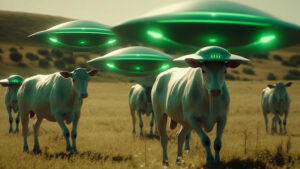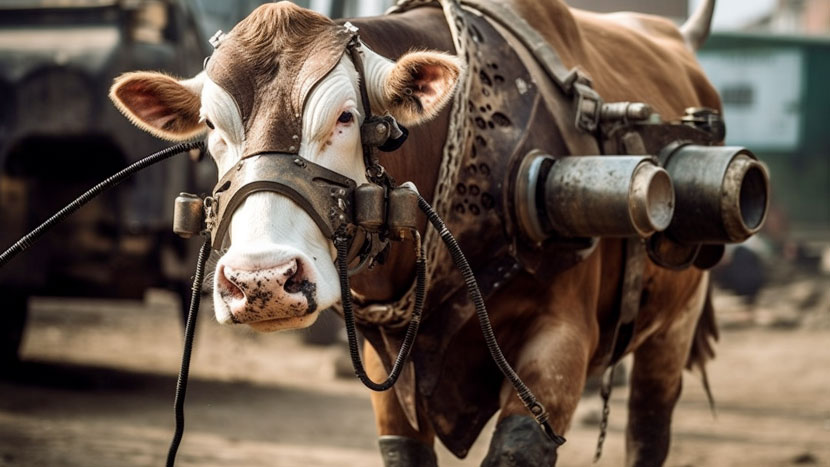AI (Artificial Intelligence) is not likely to replace cows entirely, as cows serve a unique purpose in terms of providing food products such as milk and meat, as well as other by-products like leather and fertilizer. However, AI and other technological advancements are being used in cow farming and related industries to improve efficiency, sustainability, and animal welfare.
For example, AI can be used to monitor cow health and behavior, which can help farmers detect and address potential issues before they become more serious. It can also be used to optimize feed and nutrition, reduce waste and emissions, and improve overall productivity. In addition, there are emerging technologies like cellular agriculture, where lab-grown meat is produced through the cultivation of animal cells, which could eventually reduce the need for animal agriculture altogether.
While AI and other technologies are unlikely to fully replace cows, they are likely to play an increasingly important role in shaping the future of cow farming and related industries.
AI can help reduce waste and emissions in cow farming in a number of ways. Here are a few examples:
- Optimizing feed and nutrition: By using sensors and other technologies to track the eating habits and nutrient requirements of cows, AI can help farmers develop more precise and efficient feeding programs. This can reduce the amount of feed that goes to waste, as well as minimize the amount of methane and other greenhouse gases produced during the digestion process.
- Monitoring cow health: By analyzing data on cow behavior, temperature, and other factors, AI can help farmers detect early signs of illness or other health issues in cows. This can allow for more targeted treatment and care, which can reduce the need for antibiotics and other treatments that can contribute to waste and emissions.
- Predicting and managing manure output: Manure is a major source of greenhouse gas emissions in cow farming, and it can also pose environmental risks if it is not managed properly. By using AI to track cow behavior and feeding habits, farmers can predict when and how much manure will be produced, which can help them develop more effective and sustainable manure management strategies.
- Automating farm operations: AI-powered robots and other automation tools can help farmers manage tasks like milking, feeding, and waste management more efficiently and with fewer emissions. This can reduce the need for manual labor and transportation, as well as minimize the use of fossil fuels and other resources.
Overall, by using AI and related technologies to optimize cow farming practices, farmers can reduce waste and emissions while improving productivity and animal welfare.
 It is technically possible to create hybrid AI cows in the future, but it is unclear if this would be a desirable or feasible option.
It is technically possible to create hybrid AI cows in the future, but it is unclear if this would be a desirable or feasible option.
Hybrid AI cows would likely involve integrating artificial intelligence technologies directly into the cow’s body or brain, which could have ethical and safety concerns. Additionally, it is uncertain whether such a hybrid would have any significant benefits over using traditional AI and other technologies to manage cow farming practices.
Currently, AI and other technologies are being used to optimize cow farming practices in various ways, from monitoring cow health to improving feed and nutrition. It is possible that these technologies will continue to evolve and improve in the future, without the need for creating hybrid AI cows.
However, it is important to note that advancements in genetic engineering and other related fields may make it possible to create cows with specific traits and characteristics that could improve productivity and sustainability. For example, researchers have already developed cows that produce less methane, which could help reduce greenhouse gas emissions from the livestock industry. It remains to be seen what other advancements in cow genetics and technology will arise in the future.
While it may be technically possible to install anti-pollution systems directly into a cow, it is unlikely to be a practical or effective solution to reducing greenhouse gas emissions from cow farming.
Greenhouse gas emissions from cows primarily come from their digestive process, specifically the fermentation of feed in their stomachs which produces methane gas. Methane is a potent greenhouse gas that contributes significantly to global warming.
To address this issue, various strategies have been developed to reduce methane emissions from cows, such as improving feed quality and digestion, managing manure more effectively, and reducing herd sizes. However, installing anti-pollution systems directly into a cow’s digestive system is not a viable option.
One of the main challenges with this approach is that it would require invasive surgery and pose significant health risks to the cow. It would also be very difficult to design a system that could effectively capture and treat methane gas within the cow’s digestive system. Furthermore, the costs and logistics of implementing such a system on a large scale would be prohibitive.
Instead, researchers are focusing on developing more sustainable and efficient farming practices, such as using feed additives and improving manure management. There are also promising developments in technologies like methane capture systems and biofuels, which can use cow manure to generate renewable energy while reducing greenhouse gas emissions.
Overall, while the idea of installing anti-pollution systems directly into cows may seem innovative, it is unlikely to be a practical or effective solution to reducing greenhouse gas emissions from cow farming.


0 Comments